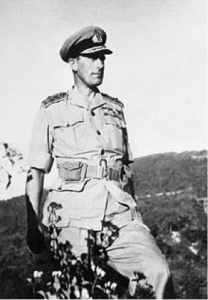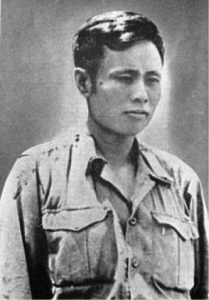Editor’s note: John Cady (1901-1996) taught history at Ohio University from 1949-1971, specializing in Southeast Asia. Before joining OU, Cady served as a research analyst with the Office of Strategic Services 1943-45 and in the Department of State 1945-49 as chief of the South Asian section, Office of Near Eastern and African Affairs, with an assignment to Consul General Rangoon 1945-46.
In a 1983 memoir, Professor Cady describes first coming to Burma in 1935 to teach history at Judson College, under the sponsorship of the Baptist Mission Board. That experience cemented his professional interest in Southeast Asia, Burma in particular.
From his vantage point in the OSS and State Department, Cady had a front row view of the situation in Burma in the final days of World War II, as the British were debating who to back among different groups of Burmese nationalists vying to take over from the Japanese occupying government. One major problem Cady notes was the lack of a U.S. policy concerning a post-colonial era in Southeast Asia. He writes that “the Foreign Officer elite within the State Department were far more interested in preserving the European balance of power than in satisfying the nationalist aspirations of Southeast Asian peoples”.
By 1946, on the threshold of the Cold War, Cady came under fire in the State Department for refusing to draw a connection between Communist political elements within Burma’s Anti-Fascist League and the Soviet Comintern. His effort to defend his analysis led to ever greater frustration with the Foreign Service. Cady joined the Ohio University faculty three years later.
Excerpted with permission of Ohio University from “Contacts with Burma, 1935-1949: A Personal Account”.
My Shift to the State Department in March 1945
[After 21 months with the OSS], I received several indications that my research endeavors on the Burma situation were attracting significant attention in Washington… The State Department needed a regional expert who could take over the Burma desk in the newly conceived Policy Division for South Asia. The prospective military occupation of the country would provide a base for future Allied operations against the Japanese in Siam and south China. During the better part of two months following my March 1945 transfer to the State Department, I divided my time between the desks assigned to me by both agencies. My older OSS quarters provided far more complete files related to Burma policy than were available in my new quarters in the State, War, and Navy Building adjacent to the White House. In later 1945, the entire Research and Analysis Branch of the wartime OSS was transferred to the State Department and renamed the Office of Intelligence Research.Varying Points of View Toward Southeast Asia
…With the exception of Siam, the region of Southeast Asia included in 1945-1946 no recognized independent government with whom to deal diplomatically. Departmental policy formulation, therefore, had to develop within a conjectural pattern of prospective post-war situations, all of which involved the interests of America’s war-time allies, including China. Our policy-formulation task was also complicated by the fact that mortally-ill President Roosevelt neglected to clarify his repeated advocacy of some type of colonial trusteeship arrangement for Southeast Asian countries as a move toward eventual self-government…

In the spring of 1945, when the Japanese military role in Burma was disintegrating, it made a great deal of difference whether the country was to be utilized as a war-time base for projecting Allied advances into other parts of Eastern Asia, as General Mountbatten assumed, or whether the reestablishment of British colonial control was a primary concern, as Simla officials tended to advocate. In either case, the intensification of Burmese nationalism could not be ignored. America’s potential role as peacemaker covering the vast colonial-ruled regions of Southeast Asia encountered both European and Asian qualifications. The prospective downfall of Hitler’s German armies involved differing implications for particular states of Western Europe. Germany’s impending downfall would afford opportunity for Soviet Communists to dominate much of Central Europe. France could be counted on to counter the developing Russian threat in Europe, but in Southeast Asia the resident French were contributing little or no cooperation with American efforts to defeat and expel the Japanese presence. The Department’s new Southeast Asia policy division learned quickly that the Foreign Officer elite within the State Department were far more interested in preserving the European balance of power than in satisfying the nationalist aspirations of Southeast Asian peoples….
The requirements of the continuing British campaign in Burma actually dictated London’s reluctant acquiescence in late March of 1945 in General Mountbatten’s decision to accept the offered assistance of Aung San’s Burma National Army against the Japanese. Prior to this decision, both the Simla Government and the London authorities had repeatedly denounced Aung San and his associates as outright traitors…

Mountbatten’s successful campaign in Burma afforded opportunity for our Southeast Asian Policy Division in Washington to advocate similar tactics for Allied forces against the Japanese elsewhere in Eastern Asia. My own policy memorandum covering the situation argued that any realistic assessment of the emerging problems in Indochina would underscore the folly of alienating nationalist aid against the common Japanese enemy. It would also be inappropriate under the circumstances to announce any overt commitment to restore French or Dutch colonial control following the expulsion of the Japanese. A later more formal SEA memorandum pointed out that French colonial authorities had contributed nothing to the war against Japan and were currently powerless to assist Allied forces in its final stages. Current French governmental affirmations that they were determined to restore European control over Indochina’s banking, investment, and trade facilities were actually contributing to the effectiveness of growing Communist propaganda to win over nationalist elements throughout Southeast Asia.
Our State Department’s Western European desk officers adopted a very different approach to the situation. Since they had to deal directly with French Embassy personnel in Washington, they wanted to avoid any unnecessary aggravation of already difficult European relations. It would be gratuitous, therefore, to introduce any reservations concerning French post-war sovereignty over Indochina …Throughout the remainder of 1945, departmental factions remained at odds with regard to Indochina policy questions…
Policy Decisions Relating to the Ending of the War
A cautious State Department policy statement covering post-war southeast Asian countries was issued on June 22, 1945. It mentioned a number of critical problems but called for strict non-interference on the part of the United States with the roles of returning European authorities. The only significant qualification was the affirmation that all colonial peoples should be afforded “an opportunity to prepare themselves for increased participation in their post-war governments, with eventual self-government as a goal…”
Developments in Burma Following My Return to Washington
The initial surprising change which I encountered upon my return to Washington in mid-April 1946 was a Departmental reorganization which had been inaugurated during the previous month. Burma’s relations had been transferred from the jurisdiction of the Southeast Asia Policy division under the Office of the Far East to that of the Middle East Division as part of the Office of the Near East and African Affairs. The latter was headed by a senior Foreign Service officer, Loy Henderson, who was destined within a few years to be assigned to the prestigious post of America’s first Ambassador to India…
Emergence of the Cold War Issue in Washington
During my period of absence from Washington in early 1946, important shifts in policy emphasis had developed within the Department. The tactics pursued by Secretary Byrnes at the Moscow Conference in December 1945 had tended to focus on American East Asian objectives rather than those in Eastern Europe. In return for Stalin’s agreement to recognize the Chiang Kai-shek regime in China and to accept American directions of Allied control over occupied Japan, Byrnes had accorded a measure of credence to Stalin’s vague assurances that border Eastern European countries, such as Rumania and Bulgaria, would be permitted political self-determination. The Russians at the Moscow conference had rejected American requests that they withdraw from Iran’s Azerbaijian border territory and also agree to international control over atomic energy utilization. Byrnes was thrown strongly on the defensive in February 1946, when it became apparent that the Soviets had no intention to respect the political freedom of Eastern European countries…
Washington’s gradual shift to the Cold War stance with respect to Europe in early 1946 was not shared by American diplomatic representatives in Eastern Asia. From the Southeast Asian point of view, Moscow played a very minor role in initiating independent movements through the area, and any Soviet threat to dominate Central Europe aroused little local concern…Cold-war partisans in Washington nevertheless fashioned a world-wide ideological confrontation, in which capitalism was being challenged by Communism, political freedom by Marxian slavery, and American influence by prospective Soviet domination. Particular situations within the countries of Southeast Asia were ignored…
It was in this developing Cold War context that my Rangoon report covering the role of Communist political elements within Burma’s Anti-Fascist League came under Departmental review in early May of 1946….the Chief of the Office of Near East and African Affairs, Loy Henderson, strongly disapproved the substance of my Burma reporting [Ed: notably the failure to establish a connection between the Burmese nationalists and Russia], It was very distressing to realize that my status within the department was in serious jeopardy along with my competence as a responsible Burma analyst. I began to understand why ambitious career officers of the Foreign Service hesitated to challenge the views of tenured high level officials within the Department.![]()
Ed: In late 1946, the British authorities pledged early self-governance for Burma, with the election of a Constituent Assembly in April 1947. The July assassination of nationalist leader Aung San upended many of the political decisions underway. Independence was declared on January 4, 1948.
